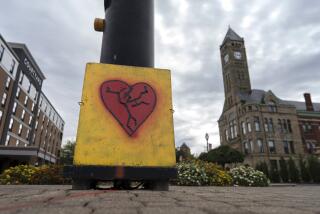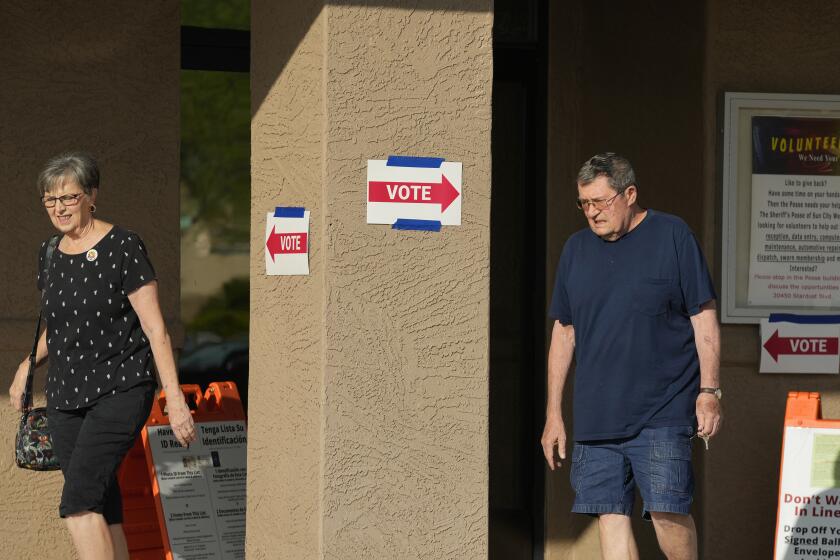Obama to propose new incentives to spur employment
Pressure on President Obama to do something about the weakening economy intensified Friday with new government data showing that hiring remains lackluster, nudging the nation’s unemployment rate up to 9.6%.
With congressional elections less than eight weeks away, Obama appeared in the Rose Garden to say that he would soon propose a new package of tax cuts and other incentives to spur employment.
“We are confident that we are moving in the right direction, but we want to keep this recovery moving stronger and accelerate the job growth that’s needed so desperately,” the president said.
Obama spoke after the Labor Department reported that the nation lost 54,000 net jobs in August, fewer than economists had expected but still dismal. The private sector’s weak gain of 67,000 jobs was wiped out largely by the number of federal census jobs that ended.
The unemployment rate edged up to 9.6% from 9.5% in July, the first increase in that figure since April.
The president is expected to use a speech in Cleveland on Wednesday to outline a series of measures to kick-start the economy, which could include extending research and development tax credits for business, increasing spending on highways and other public works projects, and retaining the middle-class portion of the Bush administration tax cuts that are set to expire at the end of the year.
Many analysts believe that those measures will have only a modest effect, especially in the short time remaining before the midterm elections. But with Republicans lined up solidly against the Democratic administration on economic policy, more far-reaching proposals are considered out of the question.
“The key will be whether it’s smart — getting bang for the buck — and if it’s big enough,” said Heidi Shierholz, an economist at the nonprofit Economic Policy Institute, a liberal-leaning research group in Washington. “And I’m concerned on both of those fronts.”
One idea that has received some support from Republicans is a three-month payroll tax holiday for all workers and businesses.
That would amount to a 6.2% tax cut for each, freeing up money that employers could use for new hiring and workers could use to boost consumer spending.
But White House aides indicated that Obama will not embrace the idea. It would cost the government about $120 billion in revenue if adopted for two months — and a staggering $700 billion if continued for a full year.
Also, an unrestricted tax holiday would not be narrowly focused on Obama’s goal of adding jobs.
“I think the notion of giving payroll tax holidays is not very well targeted,” said Gary Burtless, an economist at the Brookings Institution think tank in Washington. “That’s going to go to all kinds of firms, even those that are reducing their employees.”
Instead, Alan Krueger, the Treasury Department’s chief economist, said Obama asked his economic team to “review options that are targeted and responsible” — that is, more narrowly focused and less likely to aggravate the government’s budget and deficit problems.
Recognizing that many Americans have an unfavorable view of last year’s massive stimulus program, White House Press Secretary Robert Gibbs has been taking pains to caution that “some big new stimulus plan is not in the offing.”
Among the narrower options under consideration is extending a tax break signed into law in March that exempts employers from their share of payroll taxes for the remainder of 2010 and provides other incentives if the employer hires someone who has been unemployed for at least 60 days.
The law, known as the Hiring Incentives to Restore Employment Act, or HIRE, passed with bipartisan support, and one of its main backers, Sen. Charles E. Schumer (D-N.Y.), recently urged a six-month extension.
A White House aide, Jen Psaki, would not lay out specifics, but said that “the options under consideration build on measures the president has previously proposed.”
The moves being discussed are unlikely to change the jobs picture any time soon, Burtless said. He noted that the R&D tax credit, which expired Dec. 31, has repeatedly been renewed and is expected to be extended again this year.
The House already has approved a one-year extension, and Obama proposed a permanent extension in his 2011 budget.
“It’s going to go through regardless of whether we call it a stimulus,” Burtless said.
A permanent extension would cost about $83 billion over 10 years, but only about $5.4 billion would be spent in 2011, according to the Office of Management and Budget.
Obama’s economic policies, which have come under repeated fire from Republican leaders, faced renewed pressure after the Labor Department’s release Friday of the August employment figures.
Although the economy technically has been recovering since last summer, hiring has been so sluggish that 15 million American workers remain jobless this Labor Day weekend.
And the manufacturing sector, which had been gaining jobs, cut back for the first time this year.
Even so, many analysts considered the report to be relatively encouraging.
The net monthly drop in payroll jobs reflected the dismissal of 114,000 census workers hired temporarily for the decennial population count. The private sector’s net 67,000 increase in jobs in August came mainly in health and education services and temporary-staffing firms.
The government also revised higher the private-sector job gains for June and July, boosting the two-month total to 168,000 from 102,000.
Analysts on Wall Street were generally pleased by the jobs data because the private-sector hiring, weak as it was, came in slightly above forecasts. The Dow Jones industrial average rose 127.83 points, to 10,447.93.
“It provides at least some evidence that the economy is showing signs of life … groping for stabilization as opposed to deteriorating,” said Anthony Chan, chief economist at J.P. Morgan Private Wealth Management in New York.
After a series of recent discouraging economic indicators, particularly on the depressed housing market, many analysts had lowered their expectations. They viewed the latest job numbers as positive, a sign that the economy was not slipping toward a double-dip recession.
Even so, there was little indication in the report that the labor market and the broader economy were generating the kind of momentum required to boost hiring and create enough jobs to bring down the unemployment rate.
The nation needs to generate about 125,000 jobs a month just to keep pace with the expanding work-age population and hold the unemployment rate steady. The only reason unemployment hasn’t surged above 10% is that many people have stopped looking and are no longer counted as jobless.
For the year so far, through August, private employers have added 763,000 to their payrolls — or only about 95,000 new jobs a month.
And hiring over the last three months, on average, ran below that.
At the current pace, unemployment is widely expected to climb back up to 10% and stay high for the foreseeable future.
Riverside Mayor Ronald Loveridge, president of the National League of Cities, said it was imperative that the federal government take action.
Otherwise, job losses at the local level will continue to be a drag on the national economy for the next 18 months, he said.
He called on Congress and the administration to “set aside their partisan and ideological differences and focus on what must be their priority issue: putting Americans back to work.”
But passing even limited measures before the election will be difficult. Congress will be in session only a few weeks before members return home to campaign for the November elections. And the political atmosphere is as divisive as ever.
Obama and congressional Democrats have been struggling for months against Republican opposition to a small-business lending bill with a modest $30-billion price tag.
In unveiling his new proposals in Cleveland on Wednesday, Obama will speak at the same location where House Minority Leader John A. Boehner (R- Ohio) blasted the administration’s economic policies last month. The White House chose the site to demonstrate the differences between the two parties heading into the fall elections.
don.lee@latimes.com
peter.nicholas@latimes.com
jim.puzzanghera@latimes.com
More to Read
Get the L.A. Times Politics newsletter
Deeply reported insights into legislation, politics and policy from Sacramento, Washington and beyond. In your inbox three times per week.
You may occasionally receive promotional content from the Los Angeles Times.












